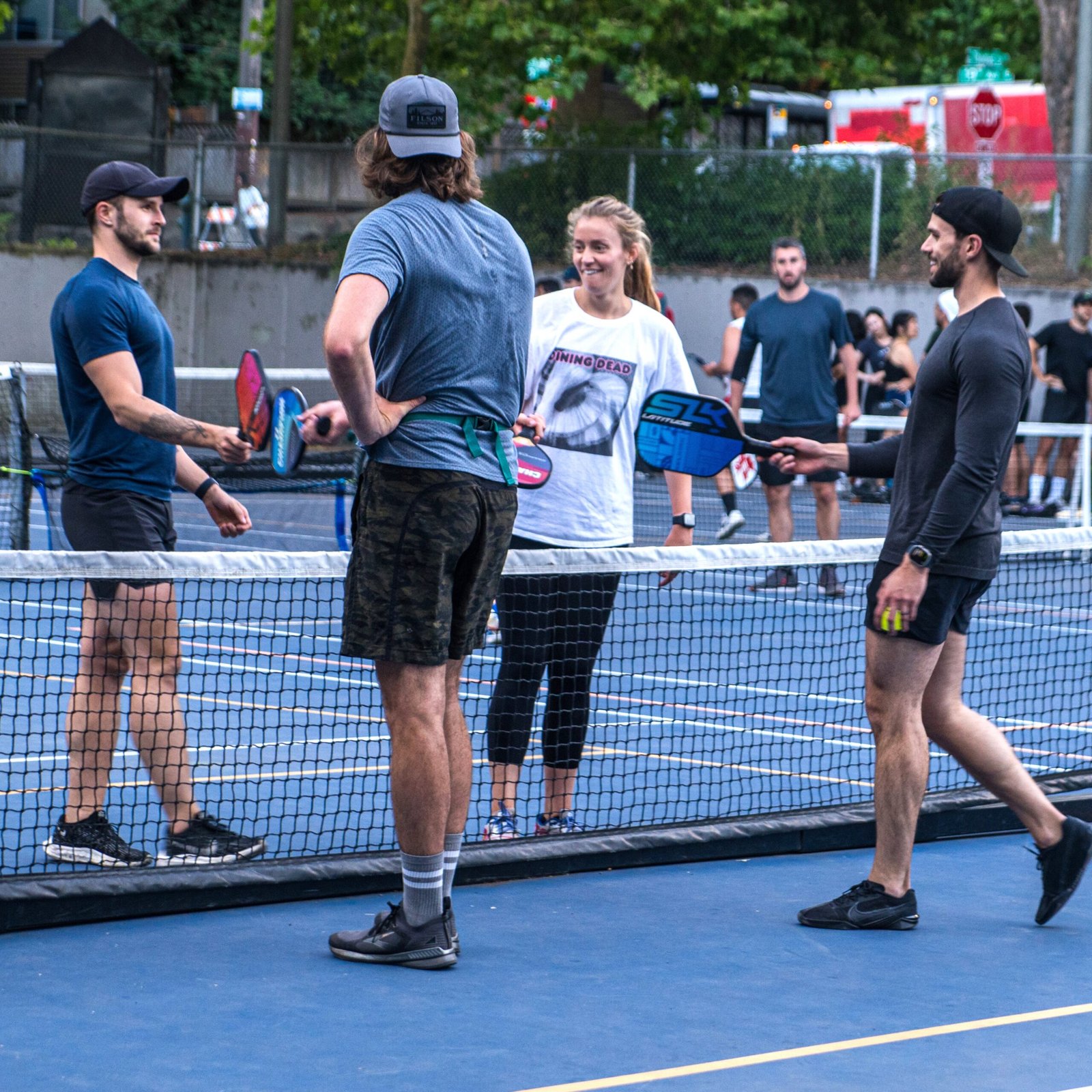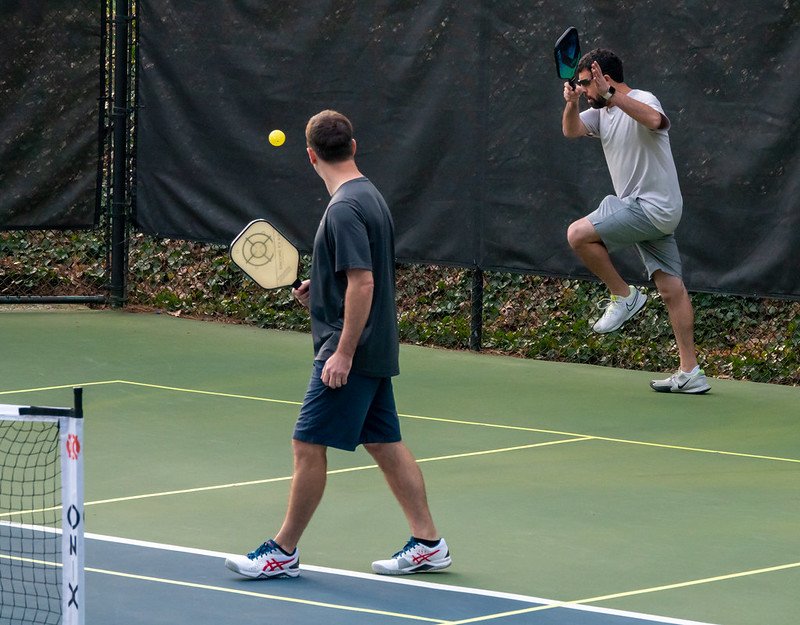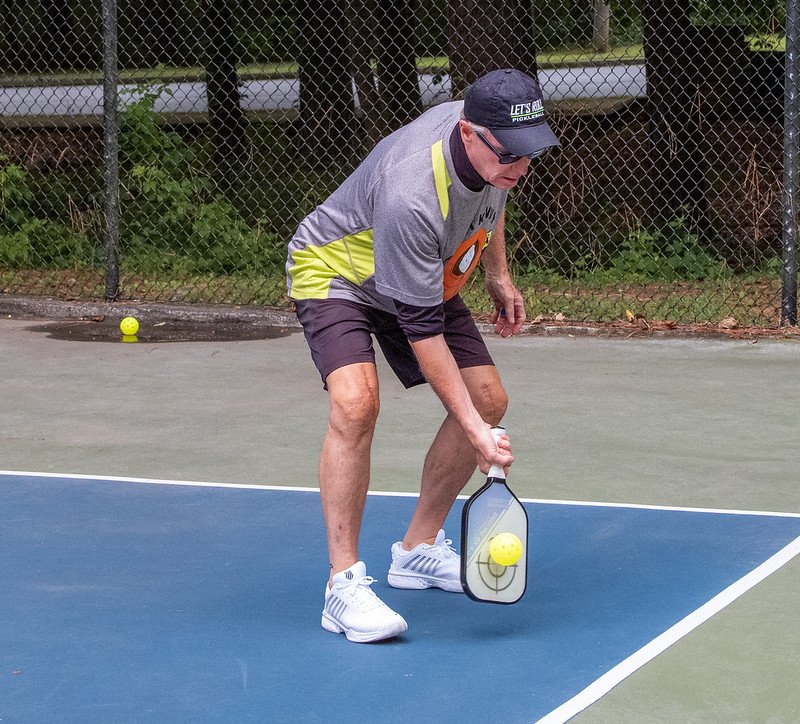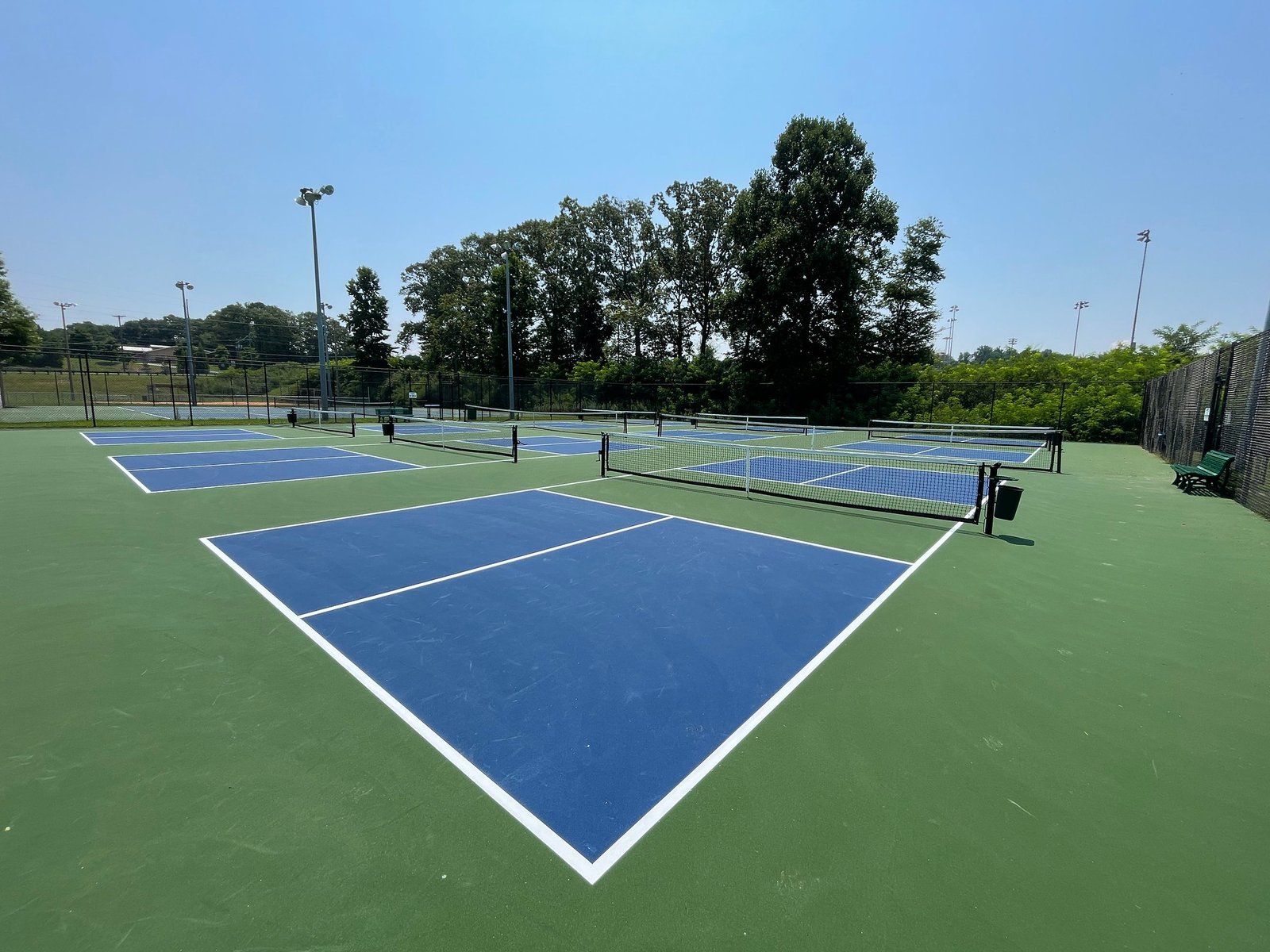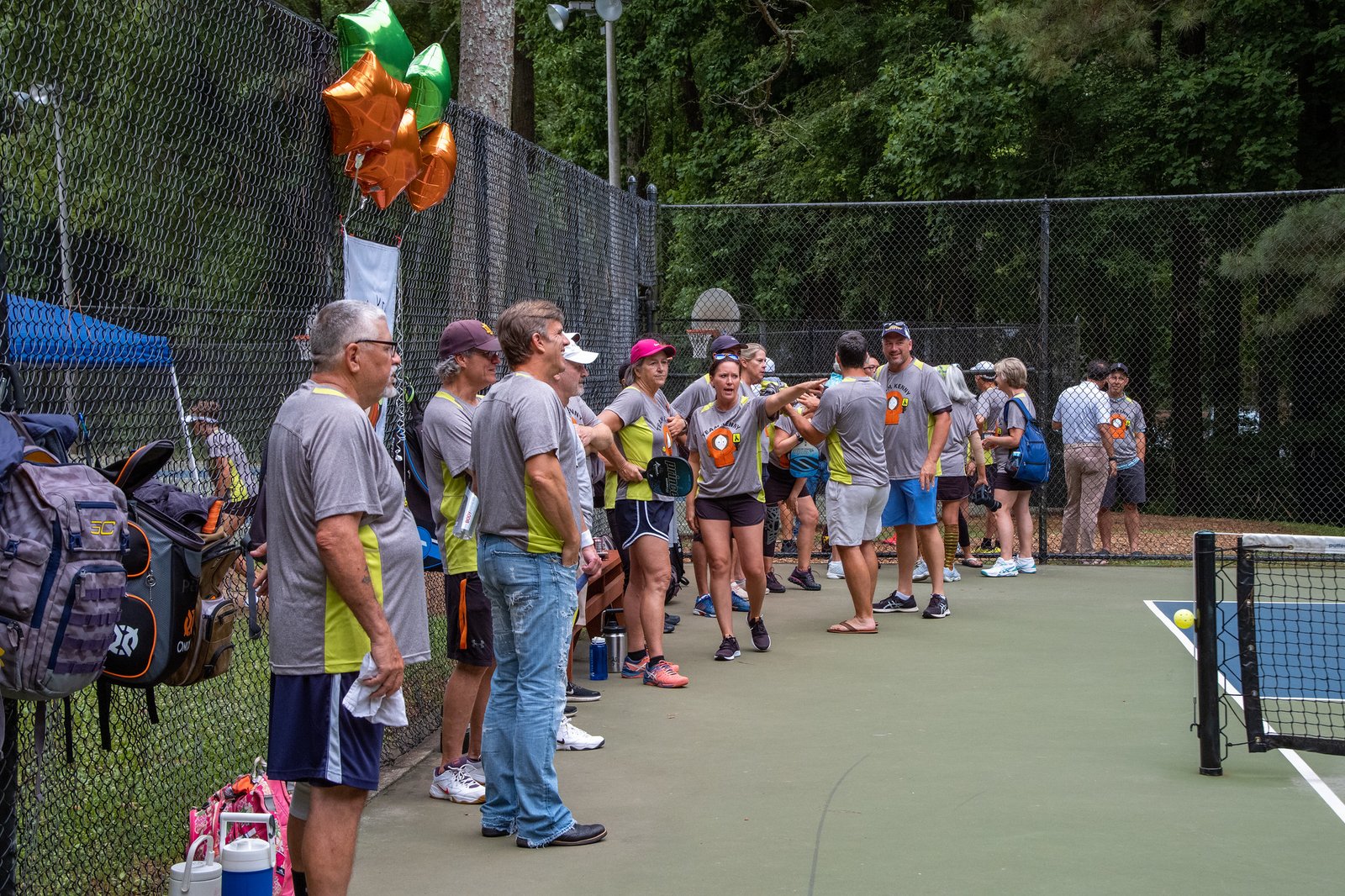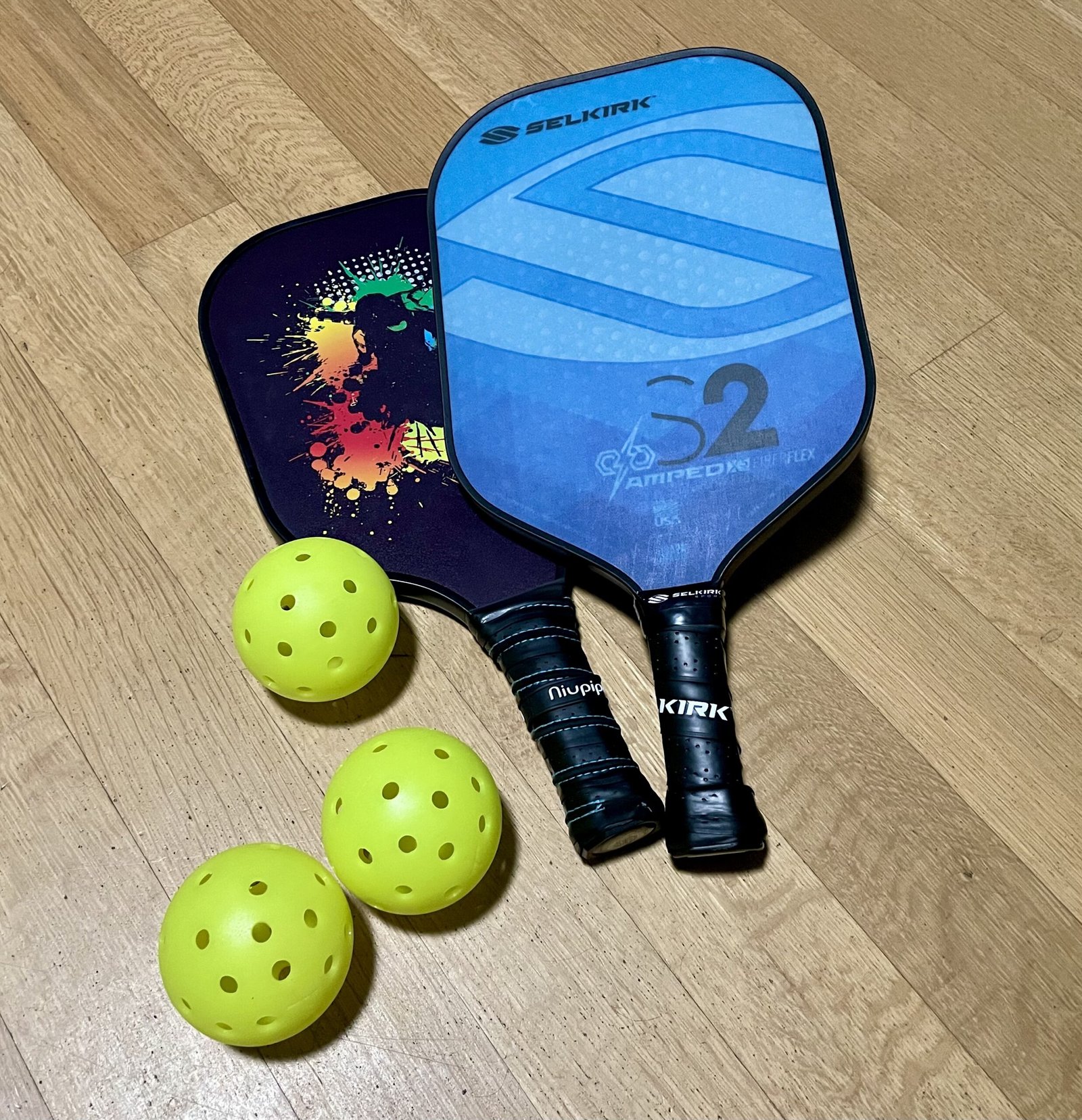In the dynamic landscape of contemporary recreation, a sport is quietly making waves and bringing together players of all ages and skill levels – pickleball. Born from the amalgamation of tennis, badminton, and table tennis, pickleball has swiftly become a global favorite, fostering a sense of community and shared enthusiasm among its diverse players. As the distinctive sound of the pickleball meeting the paddle reverberates on courts, it symbolizes not just competition but the creation of a welcoming community where both seasoned athletes and newcomers find common ground.
Pickleball’s charm lies in its straightforward nature, making it approachable for beginners and a delightful challenge for those seeking a more nuanced sporting experience. Played on a court with a modified tennis net, using solid paddles and a unique perforated ball, pickleball blends strategy, finesse, and agility. The adaptability of the court dimensions, scoring system, and gameplay further adds to the sport’s appeal, allowing players to enjoy matches in singles, doubles, or mixed doubles formats.
Beyond its engaging gameplay, pickleball has evolved into a hub for social interaction and physical well-being. From city centers to peaceful suburbs, dedicated pickleball courts echo with the laughter and camaraderie of players from various walks of life. Whether for a casual afternoon activity, friendly matches with neighbors, or more competitive endeavors, pickleball provides a space where individuals connect and revel in the joy of movement.
In this exploration of the vibrant pickleball universe, we unravel the elements that contribute to its growing popularity. From tracing its historical roots to examining the strategic finesse of players, we invite you to discover the excitement, community spirit, and timeless appeal that make pickleball more than just a sport – it’s a shared experience that brings people together on the court of life.
Table of Contents
Do people pay to play pickleball?
Pickleball is a popular racquet sport that combines elements of tennis, badminton, and table tennis. While there are public spaces and community centers that offer free or low-cost access to pickleball courts, many facilities charge fees for court rentals, especially at private clubs, dedicated pickleball facilities, or sports complexes.
The primary expense associated with playing pickleball is typically the court rental fee. Facilities may charge on an hourly basis, and the rates can vary widely depending on factors such as location, facility type, and time of day. Urban areas or regions with high demand for sports facilities may have higher prices compared to more rural or suburban locations. Additionally, prime playing times, such as evenings or weekends, may come with higher hourly rates.
Some facilities offer membership options, allowing players to pay a monthly or annual fee for access to courts at discounted rates. Memberships may come with additional benefits, such as equipment rental, priority court reservations, or participation in organized leagues and tournaments.
In addition to court fees, players might also incur costs for equipment. While some venues include paddle and ball rental in the court fee, others may charge separately for equipment. Players who prefer to use their gear may not face this additional cost.
It’s important to note that community or public facilities, such as parks and recreational centers, may provide more affordable playing options. Some local governments subsidize these spaces to encourage physical activity and community engagement.
Ultimately, whether individuals pay to play pickleball depends on their choice of venue, the level of facilities they seek, and their preferences regarding equipment and membership. The sport’s popularity has led to an increasing number of dedicated pickleball facilities, offering players various options to fit their budget and playing preferences.

What is a standard pickleball court?
A standard pickleball court is a rectangular playing surface specifically designed for the sport of pickleball. The official rules of the game standardize the court dimensions, layout, and surface characteristics. The court is similar in size to a doubles badminton court, measuring 20 feet (6.1 meters) in width and 44 feet (13.4 meters) in length, including both the playing area and the out-of-bounds zones.
Key features of a standard pickleball court include:
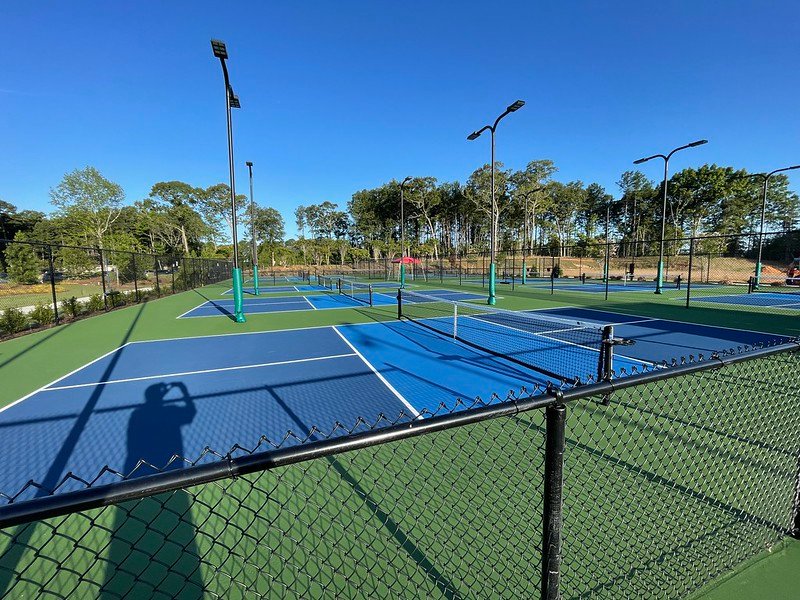
- Court Surface
The court surface is typically made of asphalt or concrete, although other materials like interlocking tiles are also used. Indoor courts may have a wooden or synthetic surface to provide better shock absorption and reduce strain on players’ joints.
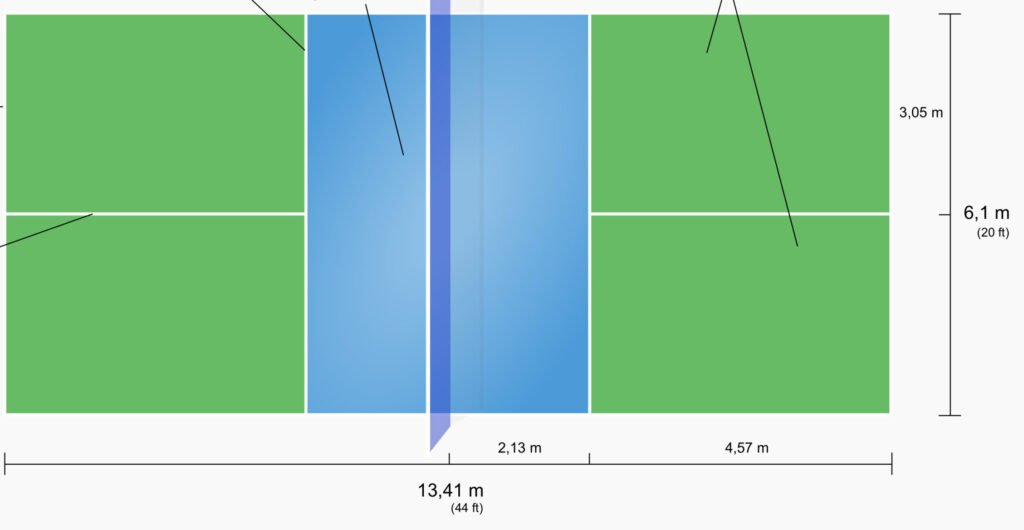
- Court Markings
The court is divided into two halves by a centerline, and each half is further divided into service courts and non-volley zones. The non-volley zone, also known as the kitchen, is a seven-foot (2.13 meters) area adjacent to the net where players are not allowed to volley the ball.

- Net and Posts
A pickleball net spans the width of the court, suspended at a height of 36 inches (0.91 meters) at the sidelines and 34 inches (0.86 meters) at the center. Net posts are placed at the sidelines, and the net should be taut with a center strap.
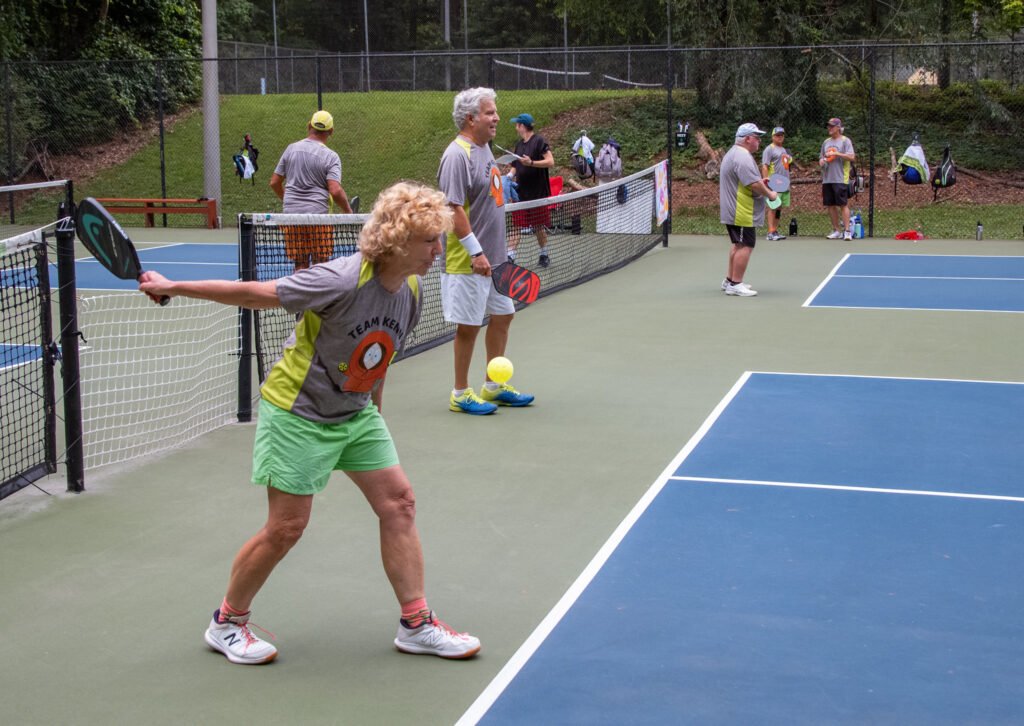
- Service Courts
Each side of the court has a service court, divided by the centerline and the nonvolley zone. The serving player must stand behind the baseline and hit the ball diagonally into the opponent’s service court.
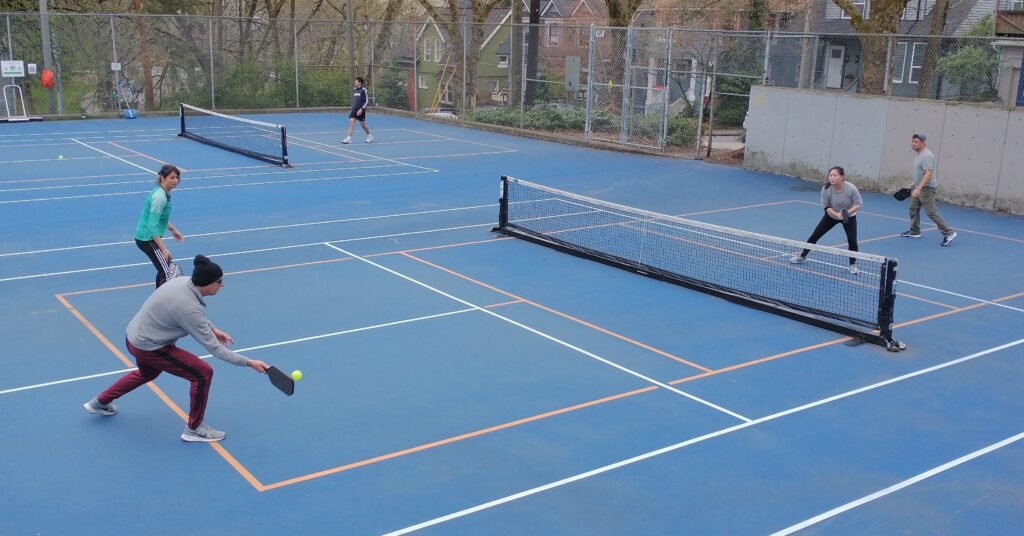
- Boundaries
The court has clear boundary lines, including baselines and sidelines, marking the playing area. The kitchen, as part of the non-volley zone, is marked with a distinctive line.
Adhering to these standardized dimensions ensures consistency in gameplay and allows players to compete on a level playing field. Whether for recreational or competitive play, having a standard pickleball court facilitates fair and enjoyable matches for participants of all skill levels.
How much does pickleball cost per hour at a standard court?
The cost of playing pickleball at a standard court can vary depending on the location, facility, and time of day. Many places offer pickleball courts as part of a larger sports or recreation facility, and the pricing structure may include hourly rates or membership fees.
In general, hourly rates for pickleball court rentals can range from $5 to $20 per hour, with variations based on factors such as location, facility amenities, and peak hours. Some facilities may also offer discounted rates for off-peak hours or provide package deals for multiple bookings.
It’s recommended to check with local sports or recreation centers, community clubs, or pickleball-specific venues in your area to get accurate and up-to-date information on court rental costs. Prices may differ between different regions and establishments.
Factors that might influence the cost:
- Location
The cost of playing pickleball can vary significantly based on the geographical location, with urban areas experiencing higher court rental rates compared to suburban or rural regions. In densely populated urban centers, the demand for sports facilities often outstrips the available supply, leading to increased prices for court rentals. Limited space and high land costs contribute to the premium pricing in these areas. Facilities in urban locales may also invest more in amenities and maintenance, reflecting the overall higher cost of play.
Moreover, the cost of playing pickleball can differ across countries or states due to varying economic factors. Economic conditions, income levels, and local market dynamics play a crucial role in determining the affordability and pricing structures of recreational activities. Wealthier regions or countries may have higher overall costs for sports facilities, including pickleball courts, as the local population may have more significant disposable income to spend on leisure activities. On the other hand, areas facing economic challenges might adopt more accessible pricing strategies to cater to a broader demographic.
The urban-rural divide and economic disparities between regions contribute significantly to the diversity in pickleball court rental costs. As players consider where to engage in this increasingly popular sport, understanding the influence of urbanization and economic factors can provide insights into the variations in pricing across different geographical locations.
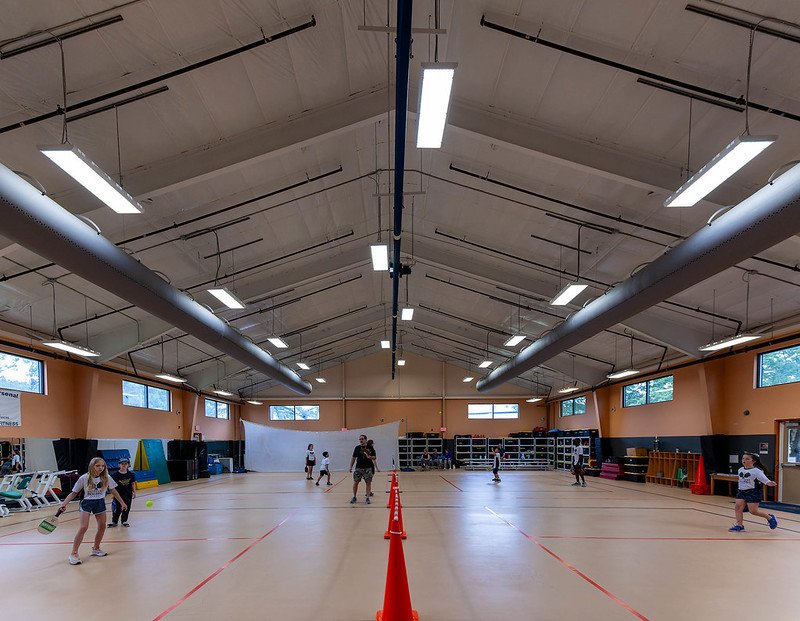
- Facility Type
Private sports clubs and dedicated pickleball facilities often have distinct pricing structures compared to public parks or recreational centers, reflecting differences in amenities, services, and overall quality. The cost differentials arise from various factors, contributing to a divergent experience for players seeking either premium or more budget-friendly options.
Private sports clubs and specialized pickleball facilities are known for their tailored services and well-maintained infrastructure. These establishments typically charge higher rates for court rentals due to the premium experience they provide. The facilities may feature state-of-the-art courts, specialized playing surfaces, and amenities like locker rooms, showers, and lounges. Additionally, these venues may offer membership packages that include perks such as priority court reservations, equipment rental, and access to exclusive events. The elevated cost is often justified by the enhanced playing environment and the additional services and benefits offered to members.
On the other hand, public parks and recreational centers, while offering a more budget-friendly alternative, might have a lower associated cost. These facilities are often subsidized by local governments or municipalities, aiming to make sports and recreational opportunities accessible to a broader demographic. While the courts may be less luxurious or specialized, they provide a cost-effective option for individuals or families seeking to engage in pickleball without significant financial commitment.
Ultimately, the choice between private sports clubs and public facilities depends on individual preferences, budget considerations, and the desired level of amenities. Players seeking a premium experience and willing to invest in a higher-quality environment may opt for private clubs. At the same time, those prioritizing affordability and community accessibility may find public parks and recreational centers more suitable for their pickleball pursuits.
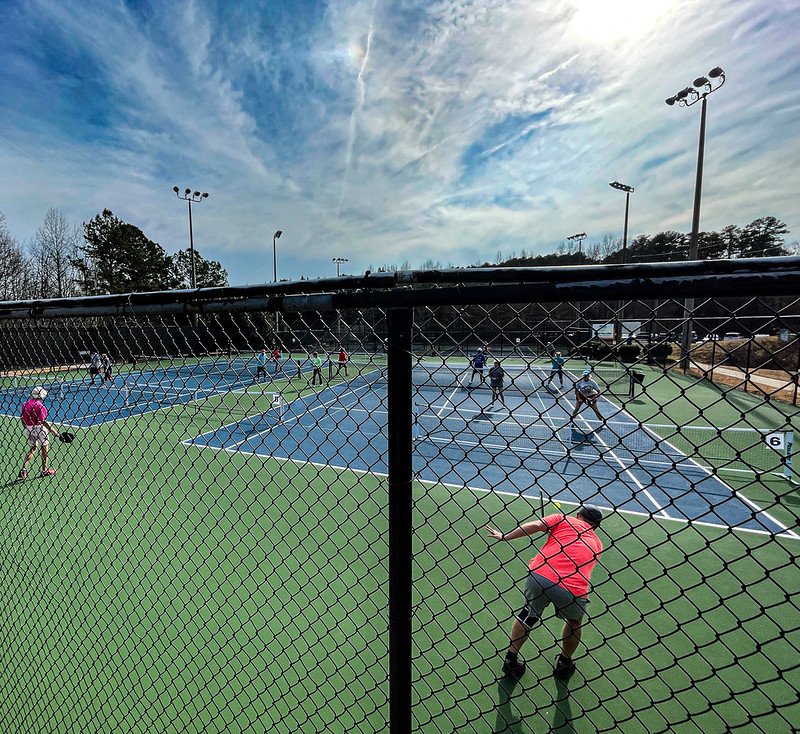
- Time of Day
The cost of playing pickleball often hinges on the timing of court reservations, with peak and off-peak hours influencing the rates at many facilities. Peak hours, typically occurring during evenings or weekends when demand for court time is high, often command higher rates. This pricing strategy aligns with the increased demand during these popular time slots, recognizing the elevated competition for court availability.
Conversely, some facilities adopt a tiered pricing structure, offering discounted rates during non-peak hours. Off-peak times, which include weekday mornings or early afternoons, are generally characterized by lower demand. By reducing rates during these periods, facilities aim to attract players during times when the courts would otherwise be underutilized. This strategy encourages a more even distribution of court usage throughout the day and week.
The implementation of peak and off-peak pricing not only reflects the economic principles of supply and demand but also serves to optimize the utilization of resources. It provides players with options based on their scheduling flexibility and budget constraints. Those seeking a more economical playing experience may choose to play during off-peak hours, while those who prioritize prime time slots may be willing to pay a premium for the convenience of evening or weekend play. Overall, this pricing flexibility caters to the diverse needs and preferences of pickleball enthusiasts, contributing to a more accessible and inclusive playing environment.
- Membership vs. Non-Membership
Many pickleball facilities offer membership options as a way to provide regular players with cost-saving benefits and additional perks. One common practice is to provide discounted rates for members, encouraging a sense of community and fostering player loyalty.
Membership fees can vary widely depending on the facility, its location, and the amenities offered. Typically, players pay a monthly or annual fee to become a member. In return, they often enjoy reduced rates when booking pickleball courts. This can be especially advantageous for players who find themselves on the courts regularly.
One attractive feature of pickleball memberships is the inclusion of extra benefits. Facilities may sweeten the deal by offering perks such as free equipment rental. This can be a significant advantage for players who don’t own their paddles and balls, as it eliminates the additional cost associated with renting or purchasing equipment separately.
Other expected membership benefits include priority access to court reservations, participation in exclusive member-only events, or discounts on lessons and clinics. These perks contribute to the overall value proposition of becoming a member, enticing players to invest in a more extended commitment to the facility.
In summary, the membership model in pickleball facilities serves as a win-win arrangement. Players gain access to discounted rates and valuable extras, while facilities benefit from a loyal customer base and a steady stream of revenue. This approach not only supports the financial sustainability of the facility but also helps build a vibrant and engaged pickleball community.
- Reservations
Pickleball enthusiasts seeking to enjoy the sport may encounter varying policies regarding court access, often influenced by factors like demand, facility management, and user convenience.
Courts are typically made available through two primary mechanisms: walk-in access and reservations. Walk-in access allows players to use available courts on a first-come, first-served basis. This system is standard in public parks or facilities with ample court space, providing a more casual and spontaneous option for players. However, during peak hours or high-demand periods, securing a court through walk-in access is challenging.
On the other hand, many facilities offer the option to reserve pickleball courts in advance. Reservations provide players with the certainty of court availability at a specified time, allowing for better planning and organized play. However, this convenience may come at an additional cost. Facilities often charge fees for court reservations, especially during popular playing times. The rationale behind this is to manage demand, optimize facility usage, and potentially generate additional revenue for the maintenance and improvement of the pickleball infrastructure.
The choice between walk-in access and reservations depends on individual preferences and the level of planning desired. Some players enjoy the spontaneity of showing up and playing when courts are available. In contrast, others prefer the assurance of a reserved court, even if it involves paying an extra fee. Ultimately, the availability and pricing structure of courts contribute significantly to the overall pickleball experience, catering to a diverse range of players and their preferred playing styles.
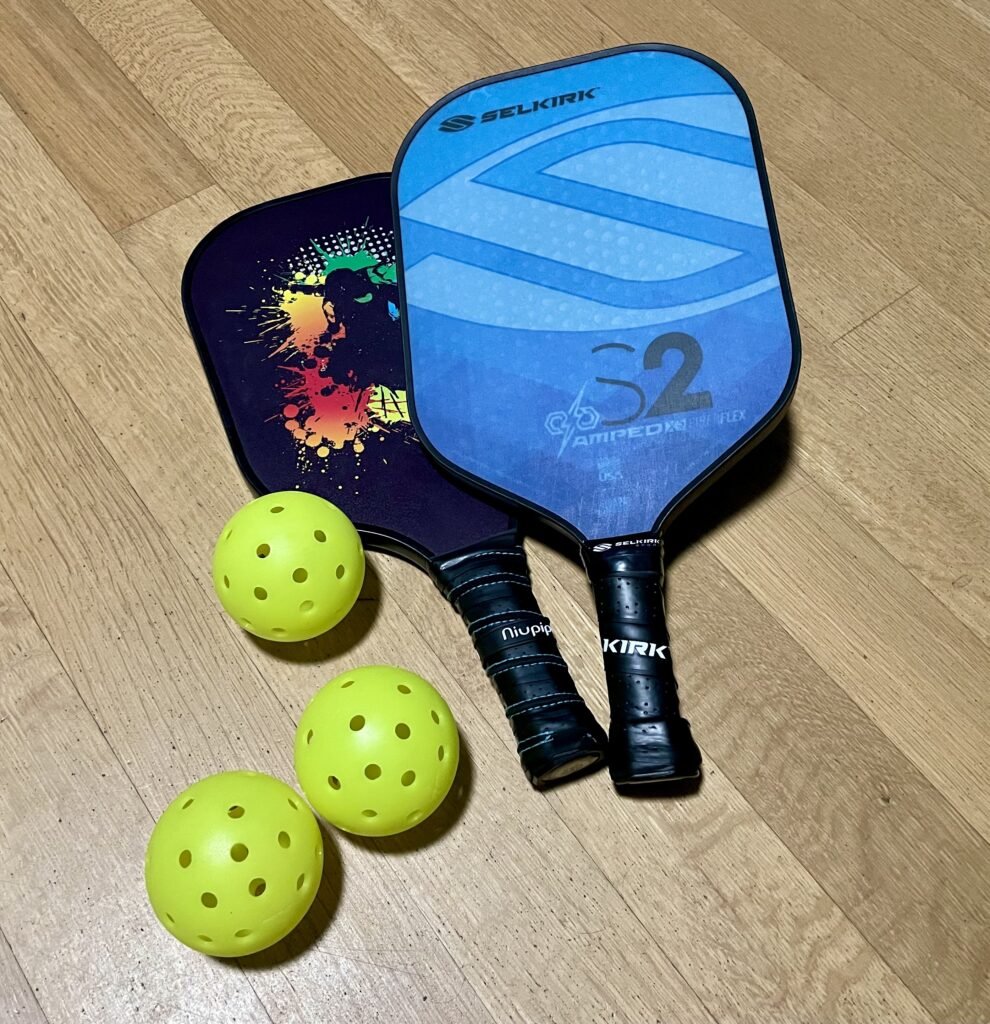
- Equipment Rental
When it comes to playing pickleball, the cost considerations extend beyond court rental and encompass equipment expenses. Different facilities have varying policies regarding equipment, and these policies can significantly influence the overall cost of playing the sport.
Some pickleball facilities bundle equipment rental with the hourly court rate. This means that when players pay for court time, they also gain access to essential equipment such as paddles and balls. This approach simplifies the payment process for players, offering a convenient and all-inclusive package. It’s especially beneficial for individuals who might not own their equipment or for those trying out pickleball for the first time.
On the other hand, some facilities opt for a separate charge for equipment rental. In this scenario, players pay an additional fee on top of the court rental cost to use paddles and balls provided by the facility. This pricing model allows players who own their equipment to save money if they prefer to utilize something other than the facility’s gear.
For individuals who own their pickleball equipment, some facilities operate on a Bring-Your-Own-Equipment (BYOE) basis. In BYOE facilities, players don’t incur extra charges for equipment rental, resulting in potentially lower overall costs. This setup is advantageous for experienced players who have invested in high-quality paddles and prefer the familiarity of their gear.
Understanding the equipment-related policies of pickleball facilities is crucial for players looking to manage costs effectively. Whether bundled with court fees, charged separately, or entirely avoided through BYOE arrangements, these approaches cater to the diverse preferences and needs of pickleball enthusiasts.
- Lesson or Program Packages
Facilities that offer pickleball lessons or programs often provide bundled packages, creating a comprehensive and convenient experience for players seeking both court time and instruction. These packages are designed to cater to individuals of varying skill levels, from beginners looking to grasp the fundamentals to more advanced players aiming to refine their techniques.
Typically, these bundled packages include access to dedicated pickleball courts for a specified duration, ensuring that players have ample time to practice what they learn during lessons. The court time is integrated into the overall cost of the package, offering a balance between structured instruction and independent play.
The instructional component of these packages involves professional guidance from experienced pickleball instructors. Lessons may cover a range of topics, including rules and etiquette, fundamental strokes, strategies for gameplay, and even specialized drills. Instructors often tailor their guidance to the skill level of the participants, providing personalized feedback and tips for improvement.
The bundled nature of these packages is advantageous for several reasons. Firstly, it simplifies the planning process for players, eliminating the need to arrange court time and lessons separately. Secondly, facilities may offer discounted rates for bundled packages compared to purchasing court time and lessons individually.
For beginners, these packages provide a seamless introduction to the sport, combining structured learning with practical application on the court. More advanced players benefit from the opportunity to refine their skills under the guidance of skilled instructors, enhancing their overall gameplay.
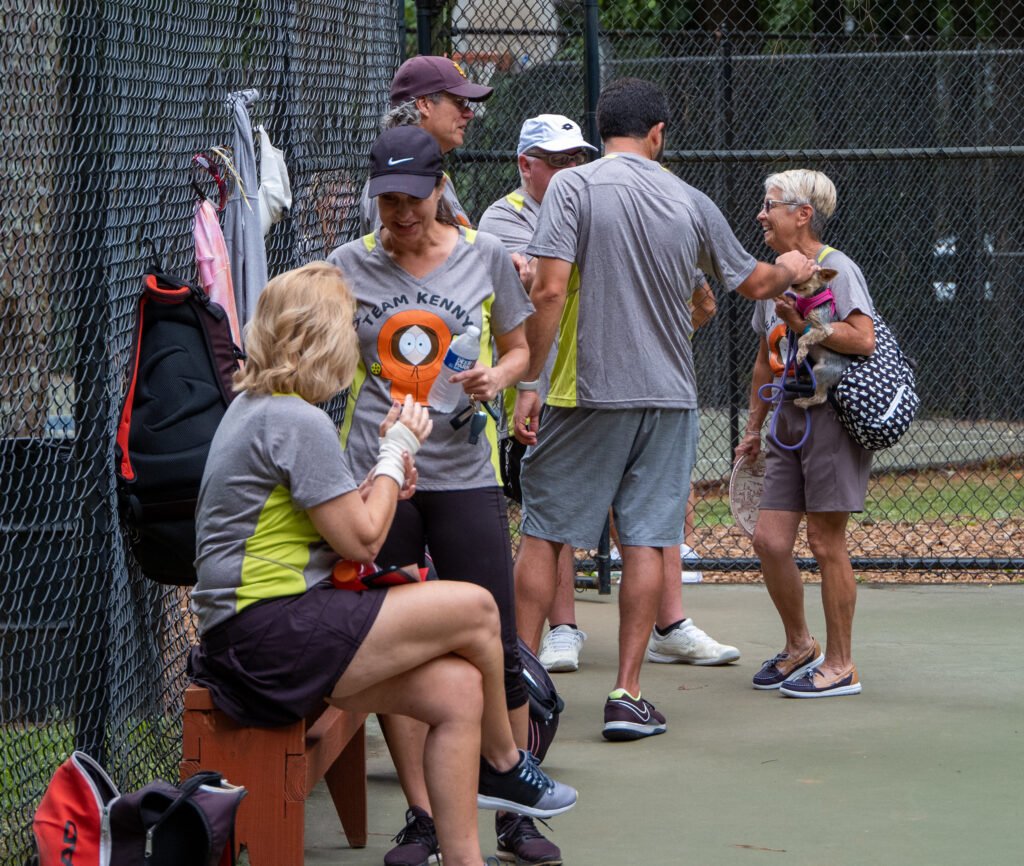
- Group Rates
Many pickleball facilities recognize the social and recreational aspects of the sport, fostering a sense of community and encouraging group participation. To accommodate this, many venues offer enticing discounts for group bookings and events. Whether it’s a gathering of friends, a corporate team-building event, or a celebration, facilities often provide special rates for reserving multiple courts to accommodate larger groups. This not only promotes inclusivity but also makes pickleball an attractive option for social outings and organized activities.
Furthermore, facilities may extend special rates for leagues and tournaments, acknowledging the role of organized competitions in promoting the sport and enhancing the overall experience for players. Leagues are structured events where participants compete regularly over a defined period, fostering friendly rivalries and skill development. Tournaments, on the other hand, are one-time events that bring together players for a more intense and competitive experience.
By offering discounted rates for leagues and tournaments, facilities encourage ongoing engagement in pickleball and provide an avenue for players to challenge themselves in a competitive setting. These special rates often cover not only court rental but may also include additional amenities or services, creating a more comprehensive and enjoyable experience for participants. Ultimately, these discounted offerings for group events, leagues, and tournaments contribute to the vibrant and social atmosphere that surrounds the sport of pickleball, attracting players of various skill levels and backgrounds to participate in the excitement of the game.
- Seasonal Variation
Outdoor pickleball courts often implement seasonal pricing to accommodate fluctuations in demand and weather conditions. This pricing strategy reflects the dynamic nature of outdoor recreational activities and aims to balance accessibility with the costs of maintenance and operation.
During the off-season, typically colder months or periods of inclement weather, outdoor pickleball facilities may experience lower demand due to reduced willingness to engage in outdoor sports. To encourage usage during these times, facilities may offer discounted rates for court rentals. This not only attracts dedicated players who are willing to brave the weather but also makes the sport more accessible to a broader audience.
Conversely, peak playing times often coincide with more favorable weather conditions, such as spring and summer. During these periods, the demand for outdoor pickleball courts tends to rise, leading to higher utilization of facilities. To manage this increased demand and optimize revenue, facilities may adjust their pricing structure by raising hourly rates. This not only helps cover the higher costs associated with maintenance and upkeep during heavy usage but also ensures a more efficient allocation of court resources.
Seasonal pricing in outdoor pickleball facilities is a strategic approach to maintaining a balance between affordability for players and the financial sustainability of the venue. It enables facilities to cater to diverse player preferences throughout the year, promoting continuous engagement with the sport while adapting to the changing seasons and weather patterns. Players can take advantage of lower rates during the off-season and anticipate the adjusted pricing during peak times, contributing to a more sustainable and accessible outdoor pickleball experience.
- Government or Community Facilities
Public parks and community centers are often affordable and accessible options for pickleball enthusiasts, providing a recreational space for individuals of all ages and skill levels. One key factor contributing to their affordability is the support they receive from local governments in the form of subsidies.
Local governments recognize the importance of promoting physical activity and community engagement, and as a result, they allocate funds to support public recreational spaces. Public parks and community centers are often recipients of these subsidies, allowing them to maintain and offer facilities at lower rates compared to private establishments.
The subsidies play a crucial role in ensuring that these spaces remain inclusive and affordable for a diverse range of community members. As a result, individuals and families can enjoy the benefits of pickleball without the financial burden often associated with private sports facilities. The affordability of public parks and community centers encourages widespread participation in sports and recreational activities, fostering a sense of community well-being.
These spaces not only provide an opportunity for physical exercise but also serve as gathering points for social interaction and community building. By offering pickleball courts at lower rates, local governments contribute to the overall health and happiness of their residents.
In conclusion, the lower rates offered by public parks and community centers for pickleball court usage stem from the financial support provided by local governments. This support reflects a commitment to making recreational opportunities accessible to everyone, promoting a healthier and more engaged community.
For the most accurate and up-to-date information on pickleball court costs, it is advisable to contact local pickleball facilities or sports clubs in your specific area. These establishments can provide detailed pricing information tailored to their unique circumstances, taking into account factors such as location, facility type, and time of day. Reach out to the facility directly to inquire about hourly rates, membership options, and any additional fees that may apply. This approach ensures that you have the latest and most relevant details, allowing you to plan your pickleball activities based on your preferences and budget. Keep in mind that prices can vary, so direct communication with the facility is the best way to obtain accurate and specific information.

